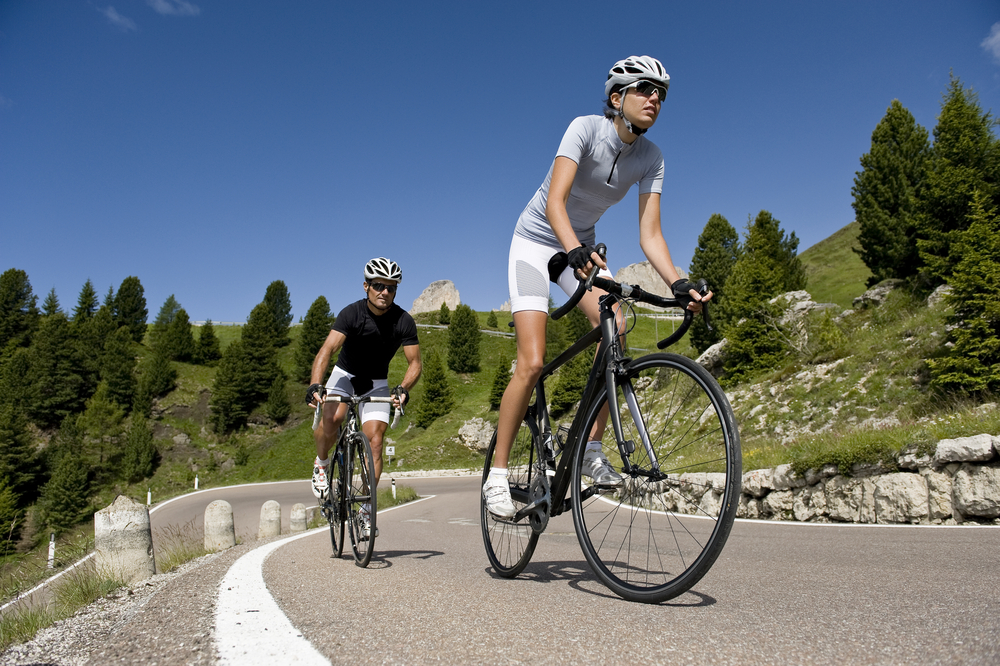Cycling in the UK has boomed in popularity over recent years due, in part, to the success of our cycling teams, whether on the track, road events and the gruelling Tour de France. However, whilst it is generally kinder to our bodies than the impact of running or contact sports such as rugby, cycling is not without its risk of injury. The most common injuries are due to overuse, poor bike set up and trauma following a collision or fall.

- Knee
The knee is the most frequent area of the cyclist’s body to be affected by overuse injuries. Patello-femoral pain at the front of the knee can be caused by muscle imbalances or tightness, poor tracking of the patella or a saddle that is too low. Additional knee problems include iliotibial band friction syndrome which produces pain on the outside of the knee, and tendinitis of the patellar and quadriceps tendons.
How to prevent and treat knee injuries
Because the leg muscles are used at high intensity when cycling, they are often short and tight. Regular stretching and the use of a foam roller will help to prevent muscle tightness. Make sure your bike has been set up correctly for your height and size. Small changes can make a huge difference to the stresses and strains on the body.
2. Back Pain
Lower back pain is not uncommon amongst cyclists and the usual cause is poor bike setup. If your saddle is too high so that your knees are almost straight at the bottom of the stroke, it will cause your pelvis to rock, leading to pain at the base of the spine. If your bike frame is too big, you will have to stretch too far forward to reach the handlebars. Poor posture on the bike can lead to strain on the muscles leading to aching or pain after long rides. Weak core muscles will accentuate poor posture and the effects of this.
How to prevent and treat back pain
Strengthening your core muscles will enable you to ride with optimum posture. Have a proper bike fit to ensure you aren’t putting unnecessary strain on your muscles and joints. If you have existing low back pain think about having a course of physiotherapy to loosen stiff joints, strengthen weak muscles and learn how to look after your back.
3. Neck and Shoulder Pain
The usual cause of neck pain when cycling is poor posture and weak shoulder blade muscles. Neck and shoulder pain is more common amongst road bike users than mountain bikers because the dropped handlebars cause the rider to have to extend the neck to look forward. If the bike frame is too large or it is not set up correctly, this will exaggerate the neck position and increase the strain.
How to prevent and treat neck and shoulder pain
Make sure your posture is correct to prevent strain on your muscles and joints. Strengthen your shoulder blade muscles by drawing your shoulder blades down your back, as if trying to put them in your back pocket! This will help prevent hunching your shoulders and overextending your neck. Regular stretches will maintain a good range of movement in your muscles. If you have recurrent or ongoing pain, see a physiotherapist to treat stiff joints and stretch tight muscles.
4. Piriformis Syndrome
Piriformis syndrome can occur in cyclists who regularly climb steep hills in too high a gear or suddenly increase their intensity of training. Pain is located deep in the hip and, because the piriformis muscle is close to the Sciatic Nerve, it can be referred down the leg. Sometimes Piriformis Syndrome is confused with a slipped disc.
How to prevent and treat Piriformis Syndrome
It is important to get this diagnosed correctly as the treatment is different to that of sciatica. As the muscles are often out of balance a good stretching and strengthening exercise programme is essential. A foam roller is great for tight muscles – painful but very effective!
5. Wrists
Carpal Tunnel Syndrome and Ulnar nerve palsy can occur if you grip the handlebars too tightly, have too much pressure on your forearms or ride with the elbows locked straight. Symptoms include numbness or pins and needles in the fingers and forearm. The scaphoid is one of the bones in the wrist which is vulnerable. When a rider falls from his bike onto an outstretched hand, if there is tenderness at the base of the thumb it is worth having it X-rayed to confirm or rule out a fractured scaphoid.
How to prevent and treat Wrist Problems
Padded gloves can help protect the wrists and hands from too much pressure. Ride with your elbows slightly bent so that they can absorb the bumps in the road. Make sure you change your hand position regularly to take pressure off the nerves. Stretches before and after your ride can also help prevent wrist soreness.
6. Clavicle (Collar Bone)
Injuries to the clavicle usually occur following a fall off the bike. The clavicle is not well protected as it is a very superficial bone so a fractured or broken clavicle is common amongst cyclists. As with a fractured scaphoid it can occur following a fall onto an outstretched hand or also directly onto the shoulder. If the clavicle hasn’t fractured but there is still pain at the front of the shoulder, the AC (acromioclavicular) joint may be sprained.
How to prevent and treat Clavicle Injuries
If you are falling off your bike, try not to land on an outstretched hand, relax and roll if possible. If your clavicle is broken it will be placed in a sling to immobilise the arm and allow it to heal. If it is badly displaced it may be fixed with a plate and screws. Obviously you will not be able to ride again until it has healed! You may need some physiotherapy when the sling is removed to get the shoulder moving properly again.
7. Bottom
Saddle sore is an unpleasant side effect of distance cycling! It is caused by friction between your skin, clothing and the saddle and can lead to uncomfortable chafing and rash. It can be exacerbated by having your saddle too high.
How to prevent and treat a Sore Bottom
Good quality padded cycling shorts can make a huge difference to your comfort in the saddle. Also a gel-padded saddle cover is worth considering. Make sure your bike set up is correct, you may need to tilt the saddle forwards slightly or lower the height of the saddle and, lastly, cyclists don’t wear underwear beneath their shorts – it only adds to the friction!
8. Head
There is only one thing to say about head injuries – always wear a helmet! They can reduce the risk of serious head injury by 85%. If you have had a fall onto your head, even if your helmet looks intact, you should replace it. The chances are it will have been damaged and will not protect you next time you fall.

Recent Comments